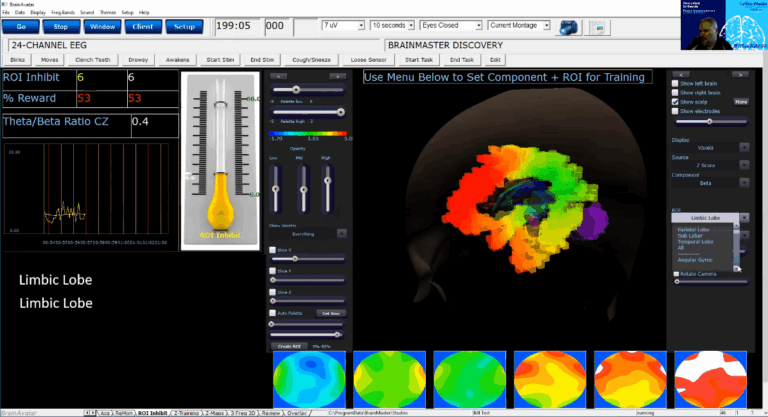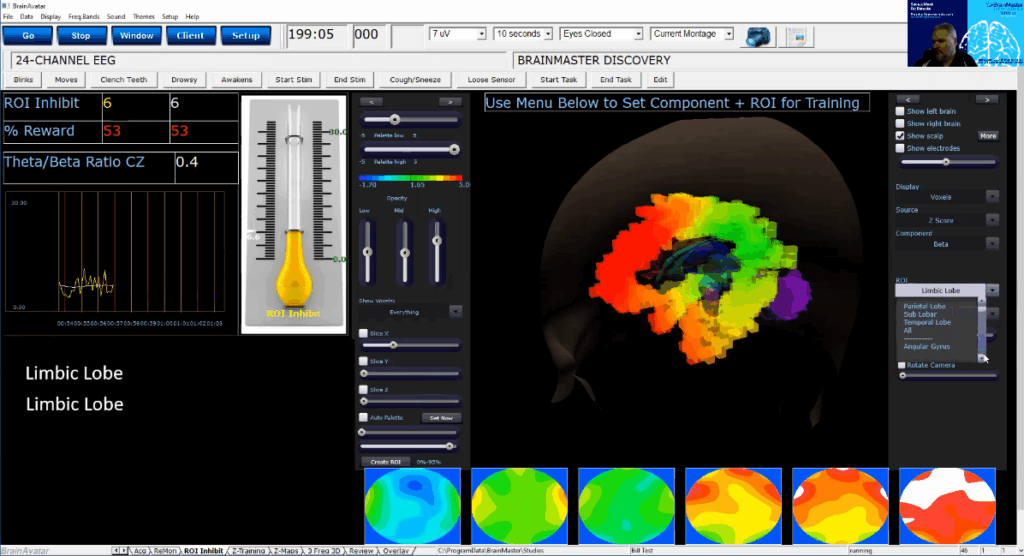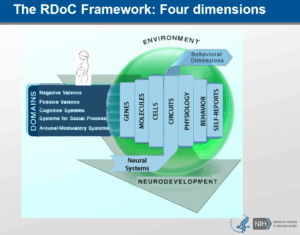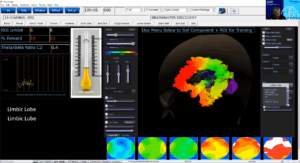
“The simplest type of breakdown exhibits itself as an oscillation in a goal-seeking process which appears only when that process is actively invoked.”
— Norbert Wiener (1988) The Human use of Human Beings: Cybernetics and Society”, p. 1163, Da Capo Press.
Z-Score Neurofeedback: Retrospect and Prospect: Reviewing the Literature
Z-score neurofeedback (ZNF) is an advanced EEG-based biofeedback technique that uses real-time statistical comparisons to normative databases to guide brain self-regulation, showing promise for conditions like ADHD, PTSD, and traumatic brain injury. This position paper defends ZNF’s efficacy by leveraging evidence from key studies, emphasizing its technical foundation in BrainMaster’s U.S. Patent 9,706,939 for multivariate whole-brain training. We critique the International Collaborative ADHD Neurofeedback (ICAN) study’s negative findings, highlighting methodological flaws identified by Schummer and Sguigna (2024), such as p-hacking, inadequate blinding, and industry bias. Additionally, we address placebo criticisms, drawing on Trullinger et al. (2019) to counter Type III statistical errors that exaggerate non-specific effects. By synthesizing recent research and historical advancements, this paper argues that ZNF is a robust, evidence-based intervention, warranting further rigorous investigation to solidify its clinical role.
NOTE: This report was constructed by Tom Collura and Bill Brubaker using the SuperGrok online AI tool to create objective review commentaries based on the published literature provided to the agent. No other information was used in the creation of this document. It is recognizably mechanical in form and grammar, as is typical of agents of the current generation of AI. We hope that readers find this information helpful and authoritative, constructed as it is from an objective analysis of the published material.

Introduction
Z-score neurofeedback (ZNF) represents a significant evolution in EEG biofeedback, utilizing real-time Z-scores—statistical deviations from normative EEG data—to train brain activity across multiple metrics (e.g., power, coherence, phase). Unlike traditional protocols focusing on specific frequency bands, ZNF’s multivariate approach targets whole-brain connectivity, minimizing risks of compensatory dysregulation. Its applications span ADHD, PTSD, traumatic brain injury (TBI), and insomnia, offering non-invasive, personalized therapy. Despite criticisms labeling it as placebo-driven, particularly from the flawed International Collaborative ADHD Neurofeedback (ICAN) study, robust evidence supports ZNF’s clinical utility. This paper defends ZNF by tracing its history, presenting empirical support, critiquing ICAN’s shortcomings, and addressing placebo concerns, using references from the provided documents.
History of Z-Score Neurofeedback
ZNF builds on quantitative EEG (qEEG) foundations from pioneers like E. Roy John, Leslie Prichep, Robert Chabot, Pedro Valdes-Sosa, Roberto Pascual-Marqui, and Robert Thatcher. A key milestone was Collura, Mrklas, and Collura, U.S. Patent 9,706,939 (issued July 18, 2017), titled “Multi-channel, multi-variate whole-head normalization and optimization system using live Z-scores” [20]. This patent details a system processing EEG to generate live Z-scores for metrics like power and connectivity, enabling multivariate proportional feedback via operant conditioning. Developed from 2007 provisional filings, it addresses single-channel limitations, targeting conditions like ADHD and post-concussion syndrome. BrainMaster’s subsequent work (2008–2023) integrated low-resolution electromagnetic tomography (LORETA, sLORETA, xLORETA), normative databases like BrainDx and QEEG Pro, and individualized ZBuilder databases, enhancing precision [8, 9, 10, 11, 12, 13, 14, 23].
Evidence Supporting Z-Score Neurofeedback Empirical studies validate ZNF’s efficacy across clinical domains. Wigton and Krigbaum (2019) reported significant improvements in attention, executive function, and electrocortical activity in a pilot study (n=21) using 19-channel ZNF, with large effect sizes [39]. Krigbaum and Wigton (2015) further substantiated the value of a single-subject controlled design approach when assessing interventions of this type. [15] Chen et al. (2023) conducted an RCT (n=87) showing LORETA ZNF improved memory and attention in TBI patients compared to usual care [3]. Hershaw and Hill-Pearson (2022) found EEG changes (e.g., increased alpha) post-ZNF predicted cognitive improvements in post-concussive syndrome [19]. Pérez-Elvira et al. (2021) identified individual alpha peak frequency as a biomarker for ZNF efficacy in learning disabilities, with significant EEG normalization [27]. A 2024 pilot by Perez-Elvira et al. used Z-scores to differentiate mild cognitive impairment risk, supporting biomarker applications [28]. Hammer et al. (2011) demonstrated ZNF’s benefits for insomnia, improving sleep and functioning [18]. These findings, alongside meta-analyses like Van Doren et al. (2019) showing sustained ADHD symptom reduction [38], affirm ZNF’s role as a targeted, evidence-based intervention.
Work done by Hershaw et. al. (2020, 2022) was affiliated with the Defense Health Agency (DHA) Traumatic Brain Injury Center of Excellence at Fort Carson, Colorado, United States. The research was conducted in a military clinical setting at Fort Carson Army Post and the surrounding Colorado Springs area, involving active-duty service members and veterans. ZNF was found to be feasible in military clinical settings, particularly due to its semi-automated nature, which allows implementation in standard offices without needing on-site NFT experts or specialized equipment beyond basic EEG hardware and software (e.g., BrainMaster) [19] [21]. Paraprofessionals can manage sessions under remote clinician oversight, reducing costs and increasing access. In the 2020 study, high tolerance and satisfaction (6.5/7 rating) were reported among completers, with significant symptom reductions comparable to traditional NFT. However, challenges include a 29% attrition rate, often from military duties like deployments, suggesting the need for shorter or more flexible protocols. The agnostic, implicit feedback approach (comparing real-time EEG to normative Z-scores without targeting specific bands) makes it suitable for diverse PPCS profiles but may limit efficacy for physical symptoms, as noted in the 2022 analysis. Overall, it supports broad deployment in resource-limited environments, though randomized trials are recommended to refine and validate superiority over targeted methods. Hershaw suggests that 19-channel Z-score training was practical. The 2020 feasibility study explicitly evaluated ZNF in a military clinical setting and concluded that it is a “clinically practical treatment” that is well-tolerated, results in high participant satisfaction, and leads to meaningful symptom improvements, despite some attrition due to external factors like military deployments. The 2022 exploratory analysis, which uses data from the same study and directly references the 19-channel EEG montage used for LZT, builds on these findings by linking EEG changes to symptom reductions, further supporting the practicality of this approach for patients with persistent post-concussive symptoms.
In recent years, ZNF has gained broader adoption, with multiple companies now offering hardware, software, and training systems to support its implementation. Notable providers include BrainMaster Technologies, Inc., offering qEEG-based Z-score tools; Thought Technology Ltd., Applied Neuroscience, Inc., the developer of NeuroGuide; Mind Media USA Inc., with Z-score modules; and Biofeedback International, providing real-time Z-score outputs. Other companies like StressTherapy Solutions, Inc., and ISF Associates deliver specialized training programs and affordable systems, making ZNF more accessible to clinicians.
Critique of the ICAN Study
The ICAN study (Neurofeedback Collaborative Group, 2021) concluded neurofeedback lacks efficacy over sham controls for ADHD at 13-month follow-up [30]. However, Schummer and Sguigna (2024) provide a scathing critique, identifying methodological flaws warranting retraction [10]. ICAN suffered from p-hacking, hypothesizing after results are known (HARKing), and non-standard protocols with insufficient session durations, deviating from established standards (e.g., Gevensleben et al., 2009) [17]. Its “double-blind” design failed to ensure proper blinding, as real and sham feedback differences risked unblinding participants, violating biofeedback guidelines (Ros et al., 2020) [29]. Selective outcome reporting and lead author Arnold’s pharmaceutical ties (e.g., MTA study) suggest bias against non-drug interventions, aligning with critiques of industry influence (McGough, 2022) [24]. These flaws render ICAN’s conclusions unreliable, especially against robust evidence like Sampedro Baena et al. (2021), which found neurofeedback improved ADHD symptoms across 9 RCTs [31].
Addressing the Placebo Argument
Critics like Thibault and Raz (2016, 2017) attribute neurofeedback’s benefits to placebo, citing psychosocial factors [34, 35, 36]. Trullinger et al. (2019) counter this by highlighting Type III statistical errors, where non-inert shams and false no-effect conclusions exaggerate placebo effects [0]. They argue that sham controls may inadvertently provide therapeutic feedback, confounding results. Properly designed studies, as advocated by Ros et al. (2020), must verify sham inertness to isolate ZNF’s specific mechanisms [29]. Evidence of EEG changes correlating with symptom improvements (e.g., Hershaw et al., 2022; Pérez-Elvira et al., 2021) supports ZNF’s physiological basis beyond placebo [19, 27]. Trullinger’s stance emphasizes rigorous methodology to affirm ZNF’s clinical validity, preventing misattribution to non-specific effects.
Conclusion
Z-score neurofeedback, grounded in BrainMaster’s patented system and supported by studies like Wigton and Krigbaum (2019), Chen et al. (2023), and Pérez-Elvira et al. (2021, 2024), offers a robust, non-invasive intervention for ADHD, TBI, and other conditions. The ICAN study’s negative findings are undermined by Schummer and Sguigna’s (2024) critique of its methodological and ethical flaws. By addressing placebo concerns through Trullinger et al.’s (2019) lens on Type III errors, ZNF’s specific efficacy is upheld. Continued research adhering to CRED-nf guidelines will further solidify ZNF’s role in personalized mental health care, benefiting patients seeking sustainable alternatives to pharmacotherapy.
To further clarify the positions of key researchers, Pérez-Elvira’s work strongly supports ZNF as an effective, targeted approach. Perez-Elivira et al. (2020) showed that live ZNF was superior to conventional theta-beta training in successfully training changes in the theta-beta ratio [25]. This underscores the comments of Enriquez-Geppert et al. (2024) who showed that the ICAN project did not in fact produce effective change in theta-beta ratio, and that a network-based approach would be more appropriate [6]. ZNF training is a network-based approach, which is one reason it may be superior to conventional power training, even when power changes are targeted. Collura (2017) demonstrated a patient who did not respond well to 20 session of power training, but then experienced considerable cognitive and behavioral improvement when treated with live z-score neurofeedback [13]. Pérez-Elvira et al. (2021) demonstrated that individual alpha peak frequency as a biomarker enhances ZNF outcomes in adolescents with learning disabilities, achieving significant EEG normalization and cognitive improvements. Their 2024 pilot study on mild cognitive impairment utilized Z-score and cordance analysis to identify risk markers, reinforcing ZNF’s role as a precise diagnostic and therapeutic tool that leverages normative databases for personalized training. This evidence positions ZNF as a critical advancement, directly addressing the need for individualized protocols.
This tension underscores the critical need for Z-score training, which bridges these perspectives by offering a data-driven, individualized approach that meets Enriquez-Geppert and Ros’s standards for specificity while countering Arns’s concerns with empirical support from Pérez-Elvira. By normalizing deviations across multiple EEG metrics (e.g., power, coherence, phase), ZNF reduces risks of compensatory dysregulation and provides a tailored intervention—precisely the refinement called for in recent critiques of less targeted methods like TBR. Indeed, the shortcomings of TBR neurofeedback highlighted in Enriquez-Geppert et al. (2024) illustrate why ZNF’s advanced, whole-brain normalization represents a superior path forward, capable of delivering measurable, sustained neurophysiological changes that translate to real-world symptom relief. Future studies should prioritize ZNF protocols adhering to emerging single-subject controlled design approaches, integrating biomarkers like those identified by Pérez-Elvira, to resolve ongoing debates and establish ZNF as a cornerstone of neuromodulation for neurodevelopmental and neuropsychiatric disorders. In an era where precision medicine is paramount, ZNF not only withstands scrutiny but emerges as an essential tool, empowering clinicians to offer evidence-based, personalized care that transforms lives beyond the limitations of conventional therapies.
References
[0] Trullinger, M., Novian, A., Russell-Chapin, L., & Pradhan, D. (2019). Perspectives on Type III Statistical Errors: Exaggerating the Effects of Placebo in Neurofeedback. NeuroRegulation, 6(1), 38–41. https://doi.org/10.15540/nr.6.1.38
[3] Chen, P. Y., Su, I. C., Shih, C. Y., Liu, Y. C., Su, Y. K., Wei, L., … & Chiu, H. Y. (2023). Effects of Neurofeedback on Cognitive Function, Productive Activity, and Quality of Life in Patients With Traumatic Brain Injury: A Randomized Controlled Trial. Neurorehabilitation and Neural Repair, 37(5), 277–287. https://doi.org/10.1177/15459683231170539
[5] Coben, R., Hammond, D. C., & Arns, M. (2019). 19 channel Z-score and LORETA neurofeedback: Does the evidence support the hype? Applied Psychophysiology and Biofeedback, 44(1), 1–8. https://doi.org/10.1007/s10484-018-9420-6
[6] Enriquez-Geppert S, Krc J, van Dijk H, deBeus RJ, Arnold LE, Arns M. (2024) Theta/Beta Ratio Neurofeedback Effects on Resting and Task-Related Theta Activity in Children with ADHD. Appl Psychophysiol Biofeedback. 2024 Dec 15. doi: 10.1007/s10484-024-09675-w. Epub ahead of print. PMID: 39674997.
[8] Collura, T. (2008). Whole head normalization using live Z-scores for connectivity training. Neuroconnections, April 2008, 12–18.
[9] Collura, T. F. (2008). Whole-Head Normalization Using Live Z-Scores for Connectivity Training, Part 2 of 2. NeuroConnections, July, 9–12.
[10] Schummer, G., & Sguigna, T. (2024). A Critical Review of: Double-Blind Placebo-Controlled Randomized Clinical Trial of Neurofeedback for Attention-Deficit/Hyperactivity Disorder With 13-Month Follow-Up. NeuroRegulation, 11(1), 92–110. https://doi.org/10.15540/nr.11.1.92
[11] Collura, T. (2008). Time EEG Z-score training: Realities and prospects. In: Evans, J., Arbanel, L., & Budsynsky, T. Quantitative EEG and Neurofeedback. Academic Press.
[12] Collura, T., Guan, J., Tarrant, J., Bailey, J., & Starr, F. (2010). EEG Biofeedback Case Studies Using Live Z-Score Training and a Normative Database. Journal of Neurotherapy, 14(1), 22–46. https://doi.org/10.1080/10874200903543963
[13] Collura, T. F. (2017). Quantitative EEG and Live Z-Score Neurofeedback—Current Clinical and Scientific Context. Biofeedback, 45(2), 25–29. https://doi.org/10.5298/1081-5937-45.1.07
[14] Collura, T. F., Keizer, A. W., Perez-Elvira, R., Warner, S., & Feiner, T. (2023). Electroencephalographic imaging and biofeedback training using Z-scores: databases and LORETA-based methods. In Introduction to Quantitative EEG and Neurofeedback (3rd ed., pp. 35–61). Academic Press. https://doi.org/10.1016/B978-0-323-89827-0.00027-9
[15] Krigbaum, G. & Wigton, N. (2015) A Methodology of Analysis for Monitoring Treatment Progression with 19-Channel Z-Score Neurofeedback (19ZNF) in a Single-Subject Design Appl Psychophysiol Biofeedback (2015) 40:139–149 DOI 10.1007/s10484-015-9274-0
[17] Gevensleben, H., Holl, B., Albrecht, B., Vogel, C., Schlamp, D., Kratz, O., … & Heinrich, H. (2009). Is neurofeedback an efficacious treatment for ADHD? A randomised controlled clinical trial. Journal of Child Psychology and Psychiatry, 50(7), 780–789. https://doi.org/10.1111/j.1469-7610.2008.02033.x
[18] Hammer, B. U., Colbert, A. P., Brown, K. A., & Ilioi, E. C. (2011). Neurofeedback for insomnia: a pilot study of Z-score SMR and individualized protocols. Applied Psychophysiology and Biofeedback, 36(4), 251–264. https://doi.org/10.1007/s10484-011-9165-y
[19] Hershaw, J. N., & Hill-Pearson, C. A. (2022). Changes in EEG Activity Following Live Z-Score Training Predict Changes in Persistent Post-concussive Symptoms: An Exploratory Analysis. Frontiers in Neurology, 13, 714913. https://doi.org/10.3389/fneur.2022.714913
[20] Collura, T. F., Mrklas, W., & Collura, T. (2017). Multi-channel, multi-variate whole-head normalization and optimization system using live Z-scores. U.S. Patent No. 9,706,939. https://patents.justia.com/patent/9706939
[21] Hershaw, J. N., & Hill-Pearson, C. A. (2022). Changes in EEG Activity Following Live Z-Score Training Predict Changes in Persistent Post-concussive Symptoms: An Exploratory Analysis. Frontiers in neurology, 13, 714913. https://doi.org/10.3389/fneur.2022.714913
[24] McGough, J. J. (2022). Neurofeedback for ADHD: Time to Call It Quits. American Journal of Psychiatry, 179(12), 888–889. https://doi.org/10.1176/appi.ajp.20220861
[25] Perez-Elvira, Ruben & Oltra-Cucarella, Javier & Carrobles, José. (2020). Comparing Live Z-Score Training and Theta/Beta Protocol to Reduce Theta-to-Beta Ratio: A Pilot Study. NeuroRegulation. 7. 58-63. 10.15540/nr.7.2.58.
[27] Pérez-Elvira, R., Oltra-Cucarella, J., Carrobles, J. A., Teodoru, M., Bacila, C., & Neamtu, B. (2021). Individual Alpha Peak Frequency, an Important Biomarker for Live Z-Score Training Neurofeedback in Adolescents with Learning Disabilities. Brain Sciences, 11(2), 167. https://doi.org/10.3390/brainsci11020167
[28] Perez-Elvira, R., Torre, L., Prieto, P., & Cabaco, A. (2024). Unraveling the Risk Landscape of Mild Cognitive Impairment: A Pilot QEEG Study With Z-Score and Cordance Analysis. NeuroRegulation, 11(3), 274–283. https://doi.org/10.15540/nr.11.3.274
[29] Ros, T., Enriquez-Geppert, S., Zotev, V., Young, K. D., Wood, G., … & Thibault, R. T. (2020). Consensus on the reporting and experimental design of clinical and cognitive-behavioural neurofeedback studies (CRED-nf checklist). Brain, 143(6), 1674–1685. https://doi.org/10.1093/brain/awaa009
[30] Neurofeedback Collaborative Group. (2021). Double-Blind Placebo-Controlled Randomized Clinical Trial of Neurofeedback for Attention-Deficit/Hyperactivity Disorder With 13-Month Follow-up. Journal of the American Academy of Child & Adolescent Psychiatry, 60(7), 841–855. https://doi.org/10.1016/j.jaac.2020.07.906
[31] Sampedro Baena, L., Fuente, G. A. C., Martos-Cabrera, M. B., Gómez-Urquiza, J. L., Albendín-García, L., Romero-Bejar, J. L., & Suleiman-Martos, N. (2021). Effects of Neurofeedback in Children with Attention-Deficit/Hyperactivity Disorder: A Systematic Review. Journal of Clinical Medicine, 10(17), 3797. https://doi.org/10.3390/jcm10173797
[34] Thibault, R. T., & Raz, A. (2017). The psychology of neurofeedback: Clinical intervention even if applied placebo. The American Psychologist, 72(7), 679–688. https://doi.org/10.1037/amp0000118
[35] Thibault, R., Lifshitz, M., & Raz, A. (2017). Neurofeedback or neuroplacebo? Brain, 140(4), 862–864. https://doi.org/10.1093/brain/awx033
[36] Thibault, R., & Raz, A. (2016). Neurofeedback: the power of psychosocial therapeutics. The Lancet Psychiatry, 3(9), e18. https://doi.org/10.1016/S2215-0366(16)30326-1
[38] Van Doren, J., Arns, M., Heinrich, H., Vollebregt, M. A., Strehl, U., & Loo, S. K. (2019). Sustained effects of neurofeedback in ADHD: a systematic review and meta-analysis. European Child & Adolescent Psychiatry, 28(3), 293–305. https://doi.org/10.1007/s00787-018-1121-4
[39] Wigton, N. L., & Krigbaum, G. (2019). Attention, Executive Function, Behavior, and Electrocortical Function, Significantly Improved With 19-Channel Z-Score Neurofeedback in a Clinical Setting: A Pilot Study. Journal of Attention Disorders, 23(4), 398–408. https://doi.org/10.1177/1087054715577135
Symptoms, Disorders, Functions, and the NIH Research Domain Criteria
Symptoms, Disorders, Functions, and the NIH Research Domain Criteria There...
Read MoreZ-Score Neurofeedback: Retrospect and Prospect: Reviewing the Literature
“The simplest type of breakdown exhibits itself as an oscillation...
Read More




